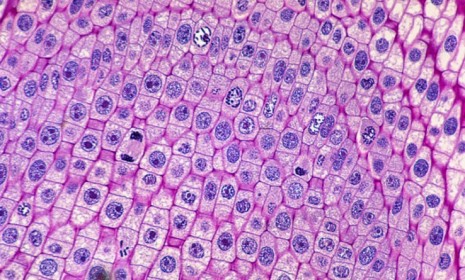Repairing a broken heart... with skin
A radical new procedure takes human tissue and transforms it into stem cells potentially capable of repairing the damaged organs of heart attack victims

For the first time ever, scientists have successfully transformed ordinary skin tissue into cells for the beating heart, a procedure that could lead to promising new therapies for recovering heart attack victims. According to the Centers for Disease Control and Prevention, about 5.8 million Americans have suffered from heart failure, with an additional 670,000 diagnosed each year. Here, a concise guide to the breakthrough that has cardiologists buzzing:
How did researchers do it?
Scientists took skin cells from two older patients who had suffered from heart failure and, in a Petri dish, they genetically reprogrammed them to become stem cells. The researchers discovered that by injecting skin cells with three genes and a molecule called valporic acid — which has been used as an anti-convulsant — the tissue could be transformed into stem cells in a younger, more immature state. These pluripotent stem cells could then be transformed into a fresh batch of heart cells.
The Week
Escape your echo chamber. Get the facts behind the news, plus analysis from multiple perspectives.

Sign up for The Week's Free Newsletters
From our morning news briefing to a weekly Good News Newsletter, get the best of The Week delivered directly to your inbox.
From our morning news briefing to a weekly Good News Newsletter, get the best of The Week delivered directly to your inbox.
What came next?
To see if their theorized technique would work, researchers injected the newly created cells into the hearts of rats. Within 48 hours, those cells had blended with the organ. "What was interesting was the cells could integrate with the rat tissue and contract in synchrony," says Lior Gepstein, a cardiologist at Technion-Israel Institute of Technology. "If you put the cells in and they beat with a completely different timing, you wouldn't see any improvement in heart function and they could even cause a dangerous [irregular heartbeat]."
Can this procedure be used on humans?
Not yet. The technique still has major obstacles to overcome. "One concern is that reprogrammed cells might grow into tumors" once implanted, says the Guardian. Another issue is that adding new heart cells could cause too much scar tissue to form, which would then have to be removed with risky surgery. Finally, collecting enough cells to offset the billions of heart muscle cells lost after a heart attack and grooming them into heart tissue could take up to two weeks, or well outside the window for treating a heart attack victim.
A free daily email with the biggest news stories of the day – and the best features from TheWeek.com
Then why are researchers excited about it?
The procedure is noteworthy because it allows the body to utilize its own cells to repair itself, thereby eliminating the risk of the immune system rejecting "foreign" stem cells taken from elsewhere.
How long until this procedure can be used on humans?
Experiments to determine if the technique is safe and effective could take up to 10 years to reach the clinical phase, maybe more. "More people are surviving following a heart attack than ever before and therefore the number of people living with a damaged heart and heart failure is increasing," Nicholas Mills, a consultant cardiologist at Edinburgh University, tells the Guardian. "Unfortunately, the body has only very limited capacity to repair the heart following a heart attack. So it's crucial for researchers to "develop effective and safe treatments to regenerate the heart."
-
 ‘The menu’s other highlights smack of the surreal’
‘The menu’s other highlights smack of the surreal’Instant Opinion Opinion, comment and editorials of the day
-
 Education: More Americans say college isn’t worth it
Education: More Americans say college isn’t worth itfeature College is costly and job prospects are vanishing
-
 One great cookbook: ‘More Than Cake’
One great cookbook: ‘More Than Cake’the week recommends The power of pastry brought to inspired life